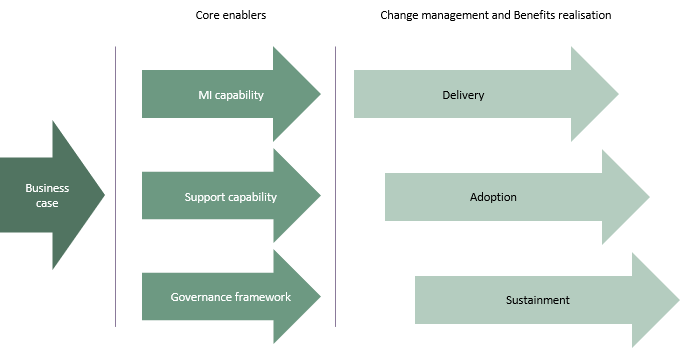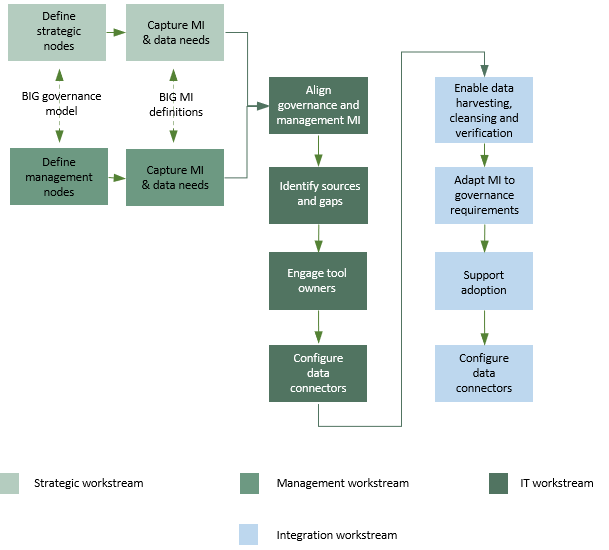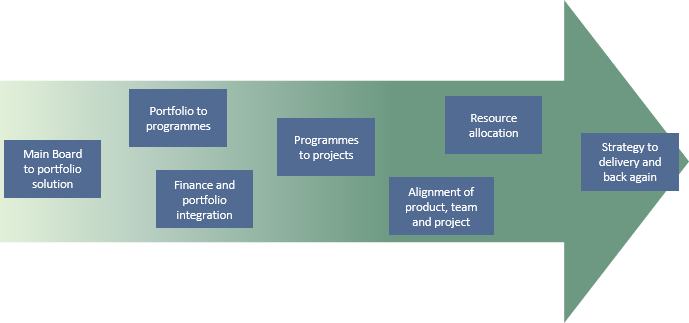Ideally, a BIG programme would be led by the Main Board. However, for tactical reasons, it may be that a bottom up or IT led approach is necessary in order to gain momentum. For example, a BIG initiative may start as a PMO project and emerge from the P3 domain, then escalate to the Main Board for sponsorship once there is initial benefit and confidence in greater success.
Objectives should be prioritised and assessed for achievability before being sequenced into a roadmap which introduces fundamental enablers, maturity growth steps and capability into stakeholder areas.
For example, the roadmap above illustrates several local ‘solutions’ that collectively make up a BIG implementation.
- Main Board to portfolio
-
OTIGs linked to OTCs and allocated to portfolios.
- Portfolio to programmes
-
Portfolio roadmap translated to programmes and projects.
- Finance and portfolio integration
-
Distribution of funding across portfolio items and products. Performance monitoring to assure effective use of funds according to priority.
- Programmes to projects
-
Translation of benefits into outcomes and project outputs. Controls to ensure projects remain aligned with objectives.
- Alignment of product, team and project
-
Clarity of business case; ownership of expenditure items; means to hold sponsors to account for performance.
- Resource allocation
-
Framework to enable effective deployment of resources according to priorities.
- Strategy to delivery and back again
-
Line of sight from OTIGs through portfolios and BAU teams to objectives achieved. Ability to adjust and adapt based on changes in circumstance and performance.
Once a roadmap is in place and the business case agreed, there are many ways to approach delivery. The illustration below shows an overall approach that first addresses core enablers (fundamental technology; business support; overall governance mapping and design) and then follows delivery, adoption and sustainment paths to realise benefits.

For each stakeholder area there are four workstreams:
- Strategic workstream (mapping and defining the governance framework)
- Management workstream (connecting governance requirements to operational needs)
- IT workstream (providing the enabling capabilities)
- Integration workstream (aligning and supporting adoption)

Engagement starts with assessment of the current state, working with governance and management stakeholders to introduce them to the framework, support and MI capabilities available. This may identify new capabilities required before proceeding (e.g. core project management skills, role definitions etc.) which may result in training and coaching to be added to the adoption workstream.
Governance and management MI requirements can then be gathered and the data implications captured, using the BIG model as a discussion tool or starting point.
These various information requirements are aligned so that the information flow from governance to management levels can be clear. Where source tools need configuration adjustment (to capture missing data) or usage needs to be adapted, tool owners are engaged to assist the process.
Thereafter, the corporate data integration capability can be configured to harvest the data required for governance reports and dashboards. Data capture can be tested, and the data quality verified and corrected.
The support team then engages users, management and governance stakeholders to adopt the overall capability and support the governance operation. This process will be repeated for different stakeholder groups and there must be overall co-ordination to ensure business integrity.
Once the capability and data are in place and the community content it has access to is supported, version 1 of Business Integrated Governance can be commissioned.
Thank you to the Core P3M Data Club for providing this page.






